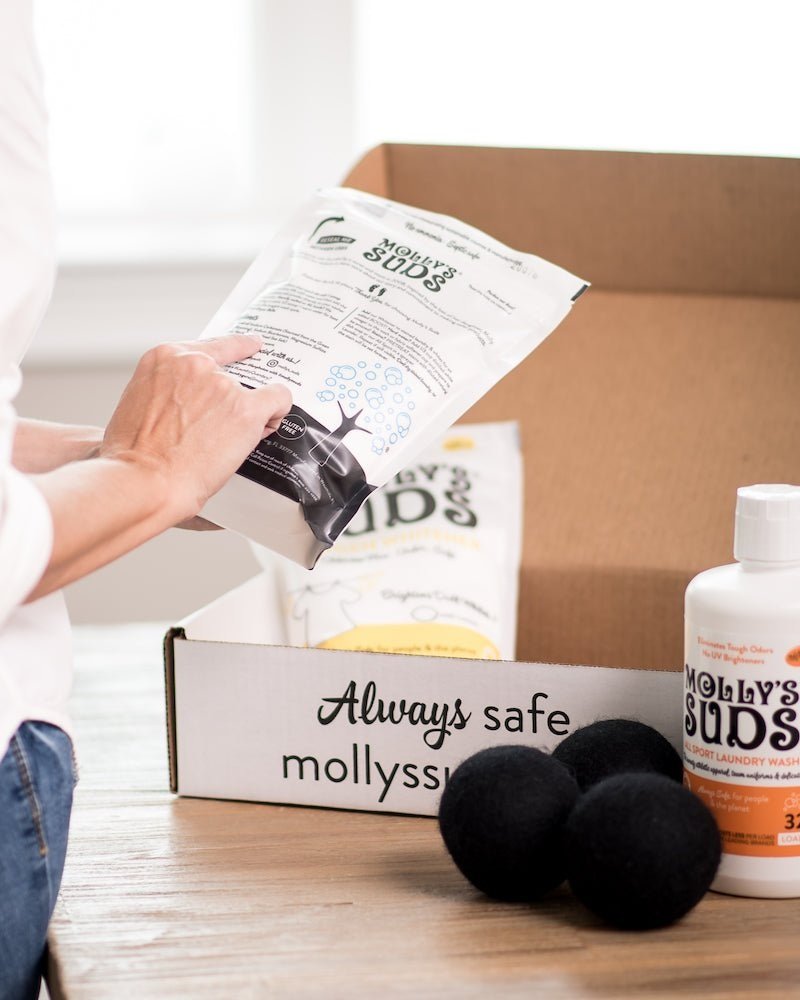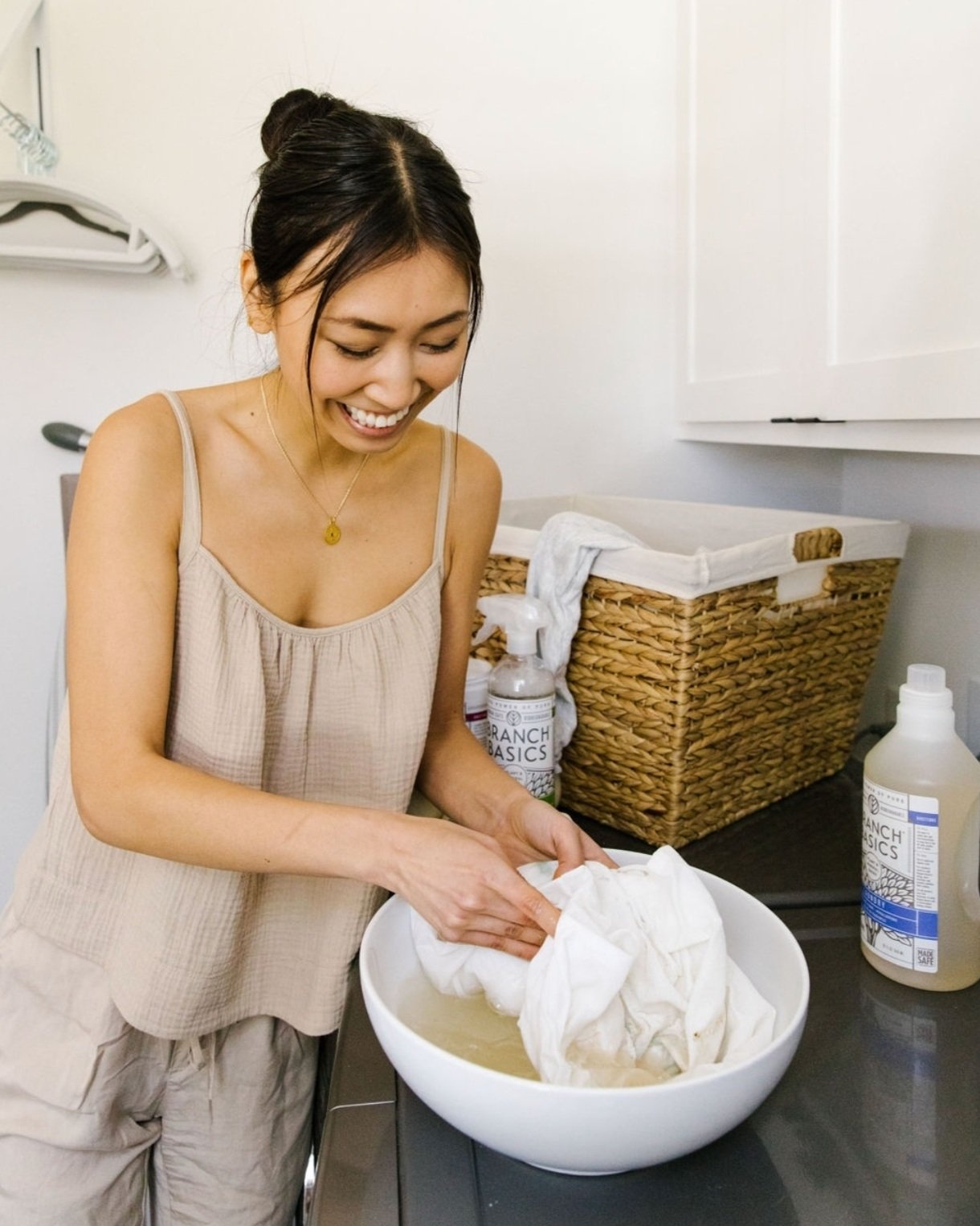Sustainable Laundry Guide
By Emma Peugh, SISTAIN Creative Director and new mama to baby E
Laundry is one of those mundane tasks that is completely necessary, yet oh so tedious (to most). To practice finding joy in the weekly, sometimes daily, laundry routine is the goal, yet seems so difficult to achieve. What’s even more overwhelming is creating a sustainable routine. Between detergents, stain removers, lights, darks, water temps, dryer balls and wash cycles, there’s a lot to unpack. Read on for SISTAIN’s approach to an attainable and sustainable laundry routine.
Washing
DETERGENT
Liquid, powder, pods, oh my. Detergent cleans your clothes, so the better the ingredients, the safer your fabrics will be when you wear them. If you have sensitive skin, it’s even more important to have safe, natural ingredients in your detergent, so that chemicals aren’t rubbing off from your clothes to your skin.
Image by Molly’s Suds
Our Picks:
MOLLY’S SUDS
“These non-toxic laundry detergents are safe, simple and effective for you and your family, and rated ‘A’ by EWG.” - Molly’s Suds
Free From: Harmful Fragrances, Dyes, Formaldehyde, 1,4-Dioxane, Volatile Organic Compounds, Synthetic Nonylphenol Ethoxylates, Phosphates, Phthalates, Methylisothiazolinone
How to Use: Toss one level scoop into the drum of your washer, then throw in clothes. Start washer and done.
Emma’s Favorite: Original Unscented Laundry Powder in bulk, $22.99
Safe for baby’s clothes and thoroughly cleans adult clothes. I buy in bulk so there is less shipping and packaging, and put the powder in a glass jar for easy access in the laundry room.
Image by Branch Basics
BRANCH BASICS
“This laundry kit makes the switch to non-toxic laundry seamless.” - Branch Basics
Sustainable Practices: Human safe, plant & mineral based, fragrance free, no harmful preservatives, biodegradable, not tested on animals, non-GMO
How to Use: Use the concentrate to mix with water and the Oxygen Boost to pour just like liquid detergent.
Emma’s Favorite: Laundry Kit, $64
Image by Seventh Generation
SEVENTH GENERATION
“EPA Safer Choice Certified and a USDA Certified Biobased Product 96% so you know it’s formulated with people and planet in mind.” - Seventh Generation
Sustainable Practices: Free of fragrances, dyes, artificial brighteners, and dermatologist tested for sensitive skin
How to Use: Use like typical liquid detergent. Packaging is made from 70% recycled cardboard and 30% recycled newspaper, molded into a rigid shape to grab and pour like a conventional bottle. Inside the shell is a plastic pouch that contains the detergent. When the bottle is empty, take off the cap, pop open the shell, and pull out the pouch. Drop all three in your home recycling bin, or compost the shell.
Emma’s Favorite: Concentrated Laundry Detergent - Free and Clear, $24 on Amazon
WATER TEMPERATURE
“About 90% of the energy the washing machine uses goes towards heating the water. According to the Sierra Club, every household that switches to cold water washing could eliminate about 1,600 pounds of carbon dioxide a year.” - coldwatersaves.org
Not to mention, cooler water saves the longevity of your clothing. The dye doesn’t fade as quickly, the fabric stays intact, and the garment is less likely to lose its shape.
Image by Molly’s Suds
STAIN REMOVAL
Stains are scary, especially when children are in the picture. I know this first hand with my little one and his love for carrot puree. But don’t be intimidated by the stain. You got this. I use Molly’s Suds natural Stain Remover Spray ($11.99) and it works like a charm. Sustainable, non-toxic, safe for all humans, truly powerful.
How to Use:
Rinse stain with cool water.
Apply stain remover spray and let sit for 10-15 minutes.
Wash with preferred detergent in cool water. If it’s a really tough stain, repeat the process!
WASHING BAG
Each time clothes made with synthetic materials are washed (we’re talking nylon, polyester, lyocell, rayon, etc), tiny pieces break off and end up in your washer. A trick to stop those sneaky microplastics from leaking into your water system? A washing bag!
“It reduces fiber from breaking significantly and thus extends the lifetime of your textiles. Using the washing bag reduces the breaking of synthetic textiles by 86% on average. The fibers that do break during washing are captured inside the bag and can easily be removed.” - Package Free Shop
Image by Package Free Shop
How to Use:
Fill bag halfway with synthetic textiles, and wash as usual.
After the wash cycle, dry clothes as usual.
Collect the microfibers from inside the bag and dispose of them in the trash.
Make sure to not rinse your bag with water or put it in the dryer.
Our Pick:
Washing Bag, $35
Drying
AIR DRY VS. THE DRYER
“In many households, the dryer is the third-most energy-hungry appliance, after the refrigerator and washer. Air-drying your clothes can reduce the average household’s carbon footprint by a whopping 2,400 pounds a year.” - Green America
Air drying also saves the quality of your clothes, immensely. Each time a garment is washed and/or dried in an electric machine, the fabric wears away little by little, eventually creating holes or overall thinned areas, causing a need to purchase new garments, which in the end, is less sustainable.
Some eco-friendly options are:
Bamboo clothing drying rack for indoors
Line dry with bamboo clothespins for outdoors
I don’t personally air dry ALL of my clothing items, but definitely the majority. Don’t feel like it’s an all or nothing process! Hang up what you can, and throw the rest in the dryer. Progress over perfection.
Image by Folchi Creative
WOOL DRYER BALLS
Wool dryer balls are used to replace single-use dryer sheets. They last years and years, over 1000 uses. They can easily be tossed in the dryer to reduce drying time by 20%, which ultimately reduces energy used. Dryer balls also reduce wrinkles and soften fabrics. Pro tip: Dab a few drops of lavender essential oil on dryer balls for a natural scent boost! Our favorite clean essential oil brand is Vitruvi.
Our Picks:
Please reach out with any questions or thoughts you have around creating a sustainable laundry routine! We’d love to hear your own tips and hacks because we’re always aiming to make laundry a more enjoyable experience.








